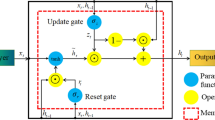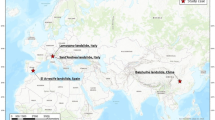Abstract
Displacement prediction plays a significant role in the landslide disaster early warning. However, landslide deformation is a complex nonlinear dynamic process, posing difficulties in the displacement prediction especially for the commonly used static models. This study applies an advanced deep machine learning method called gated recurrent unit (GRU) to the displacement prediction of the Jiuxianping landslide, which is a typical reservoir landslide located in the Yunyang County of Chongqing, China. Results show that the GRU-based approach is able to portray the variation of the periodic displacement in the testing dataset with fewer outliers. Although both the artificial neural network (ANN) and random forest regression (RFR) can capture the variation tendency of data points in the training dataset, they are unable to predict the local peaks well in the testing dataset. For the multivariate adaptive regression splines (MARS), the deformation characteristics of the periodic displacement curve cannot be well captured, and the overall predictive performance is unsatisfactory. Different from the three static models, the GRU model is essentially a dynamic model making full use of the historical information, which can portray the deformation characteristics of the Jiuxianping landslide rationally.













Similar content being viewed by others
References
Calvello M, Cascini L, Sorbino G (2008) A numerical procedure for predicting rainfall-induced movements of active landslides along pre-existing slip surfaces. Int J Numer Anal Meth Geomech 32:327–351. https://doi.org/10.1002/nag.624
Ching J, Phoon K (2014) Transformations and correlations among some clay parameters — the global database. Can Geotech J 51(6):663–685. https://doi.org/10.1139/cgj-2013-0262
Cho K, van Merriënboer B, Gulcehre C, Bougares F, Schwenk H, Bengio Y (2014) Learning phrase representations using RNN encoder-decoder for statistical machine translation. arXiv preprint arXiv: 1406.1078. https://doi.org/10.48550/arXiv.1406.1078
Du J, Yin K, Lacasse S (2013) Displacement prediction in colluvial landslides, three Gorges reservoir, China. Landslides 10:203–218. https://doi.org/10.1007/s10346-012-0326-8
Fathipour-azar H (2021) Machine learning-assisted distinct element model calibration: ANFIS, SVM, GPR, and MARS approaches. Acta Geotech. https://doi.org/10.1007/s11440-021-01303-9
Friedman JH (1991) Multivariate adaptive regression splines. Ann Stat 19:1–67
Goh ATC, Zhang RH, Wang W, Wang L, Liu HL, Zhang WG (2020) Numerical study of the effects of groundwater drawdown on ground settlement for excavation in residual soils. Acta Geotech 15(5):1259–1272. https://doi.org/10.1007/s11440-019-00843-5
Gu DM, Huang D, Yang WD, Zhu JL, Fu GY (2017) Understanding the triggering mechanism and possible kinematic evolution of a reactivated landslide in the Three Gorges Reservoir. Landslides 14:2073–2087. https://doi.org/10.1007/s10346-017-0845-4
Han H, Shi B, Zhang L (2021) Prediction of landslide sharp increase displacement by SVM with considering hysteresis of groundwater change. Eng Geol 280:105876. https://doi.org/10.1016/j.enggeo.2020.105876
Huang F, Huang J, Jiang S, Zhou C (2017) Landslide displacement prediction based on multivariate chaotic model and extreme learning machine. Eng Geol 218:173–186. https://doi.org/10.1016/j.enggeo.2017.01.016
Jibson RW (2007) Regression models for estimating coseismic landslide displacement. Eng Geol 91:209–218. https://doi.org/10.1016/j.enggeo.2007.01.013
Li X, Kong J, Wang Z (2012) Landslide displacement prediction based on combining method with optimal weight. Nat Hazards 61:635–646. https://doi.org/10.1007/s11069-011-0051-y
Li G, Sun Y, Qi C (2021) Machine learning-based constitutive models for cement-grouted coal specimens under shearing. Int J Min Sci Technol 31(5):813–823. https://doi.org/10.1016/j.ijmst.2021.08.005
Lian C, Zeng Z, Yao W, Tang H (2014) Ensemble of extreme learning machine for landslide displacement prediction based on time series analysis. Neural Comput Appl 24:99–107. https://doi.org/10.1007/s00521-013-1446-3
Liu ZQ, Guo D, Lacasse S, Li JH, Yang BB, Choi JC (2020) Algorithms for intelligent prediction of landslide displacements. J Zhejiang Univ, Sci, A 21(6):412–429. https://doi.org/10.1631/jzus.A2000005
Matsuura S, Asano S, Okamoto T (2008) Relationship between rain and/or meltwater, pore-water pressure and displacement of a reactivated landslide. Eng Geol 101:49–59. https://doi.org/10.1016/j.enggeo.2008.03.007
Merghadi A, Yunus AP, Dou J, Whiteley J, ThaiPham B, Bui DT, Avtar R, Abderrahmane B (2020) Machine learning methods for landslide susceptibility studies: a comparative overview of algorithm performance. Earth Sci Rev. https://doi.org/10.1016/j.earscirev.2020.103225
Miao F, Wu Y, Xie Y, Li Y (2018) Prediction of landslide displacement with step-like behavior based on multialgorithm optimization and a support vector regression model. Landslides 15(3):475–488. https://doi.org/10.1007/s10346-017-0883-y
Saito M (1965) Forecasting the time of occurrence of a slope failure, 6 th Int. Conf. Soil Mechanics and Foundation Eng, pp. 537–541
Saygili G, Rathje EM (2008) Empirical predictive models for earthquake-induced sliding displacements of slopes. J Geotechn Geoenvironm Eng 134:790–803. https://doi.org/10.1061/(ASCE)1090-0241(2008)134:6(790)
Shihabudheen KV, Pillai GN, Peethambaran B (2017) Prediction of landslide displacement with controlling factors using extreme learning adaptive neuro-fuzzy inference system (ELANFIS). Appl Soft Comput 61:892–904. https://doi.org/10.1016/j.asoc.2017.09.001
Tang L, Na S (2021) Comparison of machine learning methods for ground settlement prediction with different tunneling datasets. J Rock Mechan Geotechn Eng 13(6):1274–1289. https://doi.org/10.1016/j.jrmge.2021.08.006
Teza G, Galgaro A, Zaltron N, Genevois R (2007) Terrestrial laser scanner to detect landslide displacement fields: a new approach. Int J Remote Sens 28:3425–3446. https://doi.org/10.1080/01431160601024234
Wang KL, Lin ML (2011) Initiation and displacement of landslide induced by earthquake—a study of shaking table model slope test. Eng Geol 122:106–114. https://doi.org/10.1016/j.enggeo.2011.04.008
Wang FW, Zhang YM, Huo ZT, Matsumoto T, Huang BL (2004) The July 14, 2003 Qianjiangping landslide, three gorges reservoir, China. Landslides 1:157–162. https://doi.org/10.1007/s10346-004-0020-6
Wang Y, Tang H, Wen T, Ma J (2019) A hybrid intelligent approach for constructing landslide displacement prediction intervals. Appl Soft Comput 81:105506. https://doi.org/10.1016/j.asoc.2019.105506
Wang L, Wu C, Tang L, Zhang W, Lacasse S, Liu H, Gao L (2020) Efficient reliability analysis of earth dam slope stability using extreme gradient boosting method. Acta Geotech 15(11):3135–3150. https://doi.org/10.1007/s11440-020-00962-4
Wang L, Wu C, Gu X, Liu H, Mei G, Zhang W (2020) Probabilistic stability analysis of earth dam slope under transient seepage using multivariate adaptive regression splines. Bull Eng Geol Env 79(6):2763–2775. https://doi.org/10.1007/s10064-020-01730-0
Wang LQ, Wu JH, Zhang WG, Wang L, Cui W (2021) Efficient seismic stability analysis of embankment slopes subjected to water level changes using gradient boosting algorithms. Front Earth Sci. https://doi.org/10.3389/feart.2021.807317
Wang LQ, Zhang ZH, Huang BL, Hu MJ, Zhang CY (2021) Triggering mechanism and possible evolution process of the ancient Qingshi landslide in the Three Gorges Reservoir. Geomat Nat Haz Risk 12(1):3160–3174. https://doi.org/10.1080/19475705.2021.1998230
Wang J, Wang S, Su A, Xiang W, Xiong C, Blum P (2021) Simulating landslide-induced tsunamis in the Yangtze River at the Three Gorges in China. Acta Geotech. https://doi.org/10.1007/s11440-020-01131-3
Wei X, Zhang LL, Yang HQ, Zhang LM, Yao YP (2021) Machine learning for pore-water pressure time-series prediction: application of recurrent neural networks. Geosci Front 12(1):453–467. https://doi.org/10.1016/j.gsf.2020.04.011
Xie P, Zhou A, Chai B (2019) The application of long short-term memory (LSTM) method on displacement prediction of multifactor-induced landslides. IEEE Access 7:54305–54311. https://doi.org/10.1109/ACCESS.2019.2912419
Xing X, Wu C, Li J, Li X, Zhang L (2021) Susceptibility assessment for rainfall-induced landslides using a revised logistic regression method. Nat Hazards 106(1):97–117. https://doi.org/10.1007/s11069-020-04452-4
Xu S, Niu R (2018) Displacement prediction of Baijiabao landslide based on empirical mode decomposition and long short-term memory neural network in Three Gorges area, China. Comput Geosci 111:87–96. https://doi.org/10.1016/j.cageo.2017.10.013
Yang B, Yin K, Lacasse S, Liu Z (2019) Time series analysis and long short-term memory neural network to predict landslide displacement. Landslides 16(4):677–694. https://doi.org/10.1007/s10346-018-01127-x
Zhang WG, Goh ATC (2013) Multivariate adaptive regression splines for analysis of geotechnical engineering systems. Comput Geotech 48:82–95. https://doi.org/10.1016/j.compgeo.2012.09.016
Zhang WG, Goh ATC (2016) Multivariate adaptive regression splines and neural network models for prediction of pile drivability. Geosci Front 7:45–52. https://doi.org/10.1016/j.gsf.2014.10.003
Zhang WG, Li HR, Han L, Chen LL, Wang L (2022) Slope stability prediction using ensemble learning techniques: A case study in Yunyang County, Chongqing, China. J Rock Mechan Geotechn Eng https://doi.org/10.1016/j.jrmge.2021.12.011
Zhang W, Li H, Li Y, Liu H, Chen Y, Ding X (2021) Application of deep learning algorithms in geotechnical engineering: a short critical review. Artif Intell Rev 54(8):5633–5673. https://doi.org/10.1007/s10462-021-09967-1
Zhang WG, Wu CZ, Zhong HY, Li YQ, Wang L (2021) Prediction of undrained shear strength using extreme gradient boosting and random forest based on Bayesian optimization. Geosci Front 12:469–477. https://doi.org/10.1016/j.gsf.2020.03.007
Zhao R, Wang DZ, Yan RQ, Mao KZ, Shen F, Wang JJ (2018) Machine health monitoring using local feature-based gated recurrent unit networks. IEEE Trans Industr Electron 65:1539–1548. https://doi.org/10.1109/TIE.2017.2733438
Zheng YZ, Shadloo MS, Nasiri H, Maleki A, Karimipour A, Tlili I (2020) Prediction of viscosity of biodiesel blends using various artificial model and comparison with empirical correlations. Renewable Energy 153:1296–1306. https://doi.org/10.1016/j.renene.2020.02.087
Zhou C, Yin K, Cao Y, Ahmed B (2016) Application of time series analysis and PSO–SVM model in predicting the Bazimen landslide in the Three Gorges Reservoir, China. Eng Geol 204:108–120. https://doi.org/10.1016/j.enggeo.2016.02.009
Zhou C, Yin KL, Cao Y, Intrieri E, Ahmed B, Catani F (2018) Displacement prediction of step-like landslide by applying a novel kernel extreme learning machine method. Landslides 15(11):2211–2225. https://doi.org/10.1007/s10346-018-1022-0
Zhou J, Qiu Y, Armaghani DJ, Zhang W, Li C, Zhu S, Tarinejad R (2021) Predicting TBM penetration rate in hard rock condition: a comparative study among six XGB-based metaheuristic techniques. Geosci Front 12(3):101091. https://doi.org/10.1016/j.gsf.2020.09.020
Acknowledgements
The authors are grateful to the financial supports from National Key R&D Program of China (2019YFC1509605), National Natural Science Foundation of China (52008058), Program of Distinguished Young Scholars, Natural Science Foundation of Chongqing, China (cstc2020jcyj-jq0087), and China Postdoctoral Science Foundation (2021M700608). The original data and codes used in this study are available from the corresponding author upon reasonable request.
Author information
Authors and Affiliations
Corresponding author
Additional information
Publisher's Note
Springer Nature remains neutral with regard to jurisdictional claims in published maps and institutional affiliations.
Rights and permissions
About this article
Cite this article
Zhang, W., Li, H., Tang, L. et al. Displacement prediction of Jiuxianping landslide using gated recurrent unit (GRU) networks. Acta Geotech. 17, 1367–1382 (2022). https://doi.org/10.1007/s11440-022-01495-8
Received:
Accepted:
Published:
Issue Date:
DOI: https://doi.org/10.1007/s11440-022-01495-8




